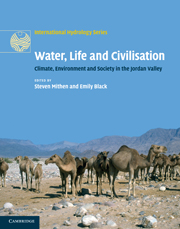Book contents
- Frontmatter
- Contents
- List of figures
- List of tables
- List of contributors
- Acknowledgements
- 1 Introduction: an interdisciplinary approach to Water, Life and Civilisation
- Part I Past, present and future climate
- Part II The palaeoenvironmental record
- Part III Hydrological studies of the Jordan Valley
- Part IV Human settlement, climate change, hydrology and water management
- Part V Palaeoeconomies and developing archaeological methodologies
- Part VI Society, economy and water today
- 24 Current water demands and future strategies under changing climatic conditions
- 25 Water reuse for irrigated agriculture in Jordan: soil sustainability, perceptions and management
- 26 Social equity issues and water supply under conditions of ‘water stress’: a study of low- and high-income households in Greater Amman, Jordan
- 27 The role of water and land management policies in contemporary socio-economic development in Wadi Faynan
- 28 Political discourses and public narratives on water supply issues in Amman, Jordan
- Part VII Conclusions
- Index
- Plate section
- References
24 - Current water demands and future strategies under changing climatic conditions
from Part VI - Society, economy and water today
Published online by Cambridge University Press: 26 April 2011
- Frontmatter
- Contents
- List of figures
- List of tables
- List of contributors
- Acknowledgements
- 1 Introduction: an interdisciplinary approach to Water, Life and Civilisation
- Part I Past, present and future climate
- Part II The palaeoenvironmental record
- Part III Hydrological studies of the Jordan Valley
- Part IV Human settlement, climate change, hydrology and water management
- Part V Palaeoeconomies and developing archaeological methodologies
- Part VI Society, economy and water today
- 24 Current water demands and future strategies under changing climatic conditions
- 25 Water reuse for irrigated agriculture in Jordan: soil sustainability, perceptions and management
- 26 Social equity issues and water supply under conditions of ‘water stress’: a study of low- and high-income households in Greater Amman, Jordan
- 27 The role of water and land management policies in contemporary socio-economic development in Wadi Faynan
- 28 Political discourses and public narratives on water supply issues in Amman, Jordan
- Part VII Conclusions
- Index
- Plate section
- References
Summary
ABSTRACT
Jordan is currently one of the world's 10 water-poorest nations, a situation which has been exacerbated by a rapidly growing population. This chapter reviews the current status of the water resources in the Hashemite Kingdom of Jordan in the context of the global pattern of increasing demand for water linked to population growth which is increasingly urban-based, increasing economic progress and the potential impact of climate change. Jordan's climate ranges from Mediterranean to arid with approximately 80% of the country receiving less than 100 mm of rainfall annually. Evaporation ranges from 2,000 mm in the north to 5,000 mm in the south. Current demand for water exceeds available renewable water resources, with the shortfall met by exploiting non-renewable reserves and water rationing. An additional water supply available for agricultural use is treated wastewater, but there are concerns and limitations to the use of this resource. The demand for water is predicted to continue to grow, and current predictions of future climate in the region indicate no change or a reduction in the quantity of rainfall and changes in the distribution through the year. These predictions of growth in water demand and shifts in rainfall patterns highlight the need to make more efficient use of the available water and to use other sustainable sources such as treated wastewater in a more effective manner.
- Type
- Chapter
- Information
- Water, Life and CivilisationClimate, Environment and Society in the Jordan Valley, pp. 403 - 414Publisher: Cambridge University PressPrint publication year: 2011
References
- 2
- Cited by



